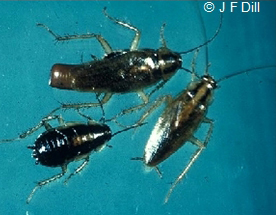What are cockroaches?
Cockroaches are insects with six legs. They have long antennae, long legs, and two pairs of wings. Adults are about ½ to 1 inch long depending on the type of cockroach. In Arlington, the three most common types are German cockroaches, Oriental cockroaches, and American cockroaches. They are considered household pests.

Where do cockroaches live?
Cockroaches like to live in groups. They prefer places that are dark, warm, and humid. Bathrooms, kitchens, basements, drains, and crawl spaces are common hiding places. Cockroaches are most active at night and will hide in cracks and crevices during the day.
What do cockroaches eat?
Diets vary among cockroach types. Common food includes human food, pet food, grease, soap, potted plants, and even paper. Cockroaches hide during the day and come out at night to look for food. They can live a very long time without food or water.
Cockroaches can pose a health risk to some individuals. Cockroach dust is made up of saliva, droppings, and decomposing body parts. This dust can trigger asthma symptoms in sensitive adults and children.
Cockroaches can also carry bacteria such as E. coli and salmonella on their legs and bodies. They can contaminate food, cooking equipment, and surfaces they walk on.
Getting rid of cockroaches is not easy. You must first determine where the cockroaches are located. Some locations may be difficult to reach. Get rid of food, water sources, and hiding places in your home. Below are options for getting rid of cockroaches. You can also hire a pest control professional if you have a large infestation or if you do not feel comfortable with do-it-yourself methods. Learn more about hiring a pest control company.
Please read product labels and use only as directed.
- Vacuum
- Inexpensive and effective way to reduce cockroaches and remove dirt and food particles
- Use a vacuum cleaner with HEPA (high efficiency particulate air) filter.
- Empty contents into sealed plastic bag. Discard immediately.
- Bait
- Bait can be packaged as pastes, gels, granules, or dust.
- Slow-acting, may take 7 days or more.
- Can be effective for long-term control if all food sources are eliminated.
- Borate powder
- Effective chemical treatment.
- Sprinkle behind and under stoves, refrigerators, and sinks.
- It may take several days to begin to kill cockroaches but it can last for years.
- Keep away from children and pets.
- Aerosol sprays
- Sprays will not control an infestation, they will only kill individual cockroaches.
- Look for sprays that are labeled “for roaches” and “for indoor use.”
- Do not use sprays where you prepare or store food, or where children play, crawl, or sleep.
Contact the Housing Information Center for information, referrals, advice, and dispute mediation regarding the rights and responsibilities of tenants and landlords. Call 703-228-3765 or visit their website.